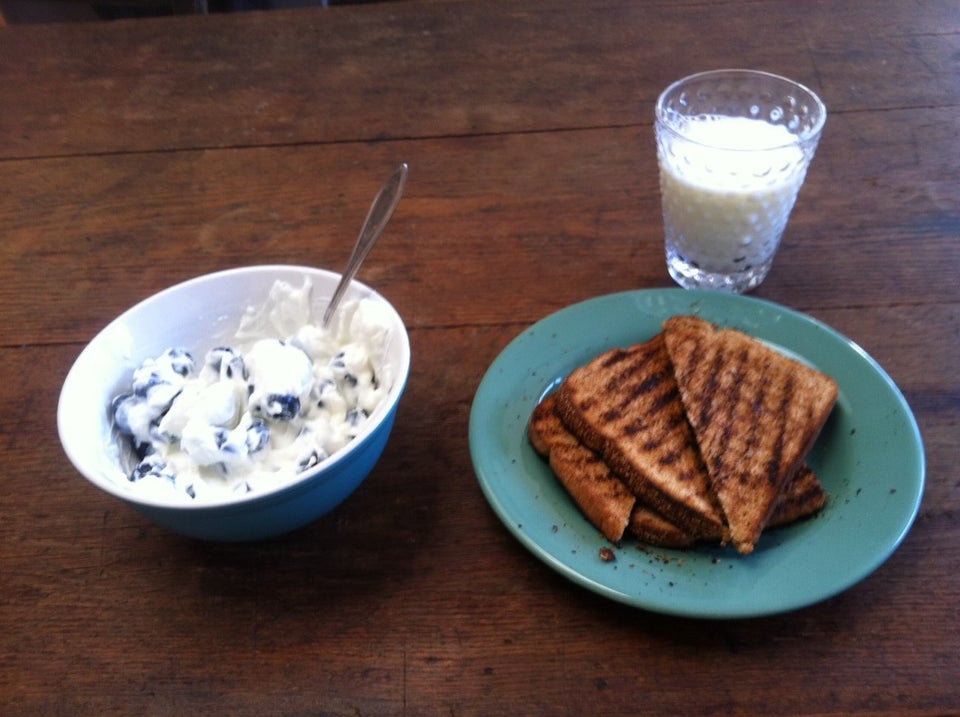
Last week, I tried my hardest to eat exactly according to the USDA's Dietary Guidelines for Americans. I did so, mostly, because I was curious how obeying Uncle Sam's controversial mandate would affect someone who's more likely to eat deep-fried pork belly for dinner than brown rice and broccoli -- whether I would lose or gain weight, whether I would feel better or worse, whether I would like or hate the food.
I planned, photographed and logged everything I ate in an effort to come as close as possible to the Dietary Guidelines. (Scroll down to the bottom of the post if you just want to be a culinary peeping tom and not listen to me ramble on.)
Despite all my work (and the ample advantages I had undertaking the project vis-a-vis the average American: no kids to feed, enough money, a good bodega around the corner, the ability to cook), I quickly discovered that the Guidelines are almost impossible to follow. As a result, I failed in my stated mission. I didn't actually meet all the guidelines on any single day. I met protein, fruits and vegetables pretty much every day, and I stayed very close to my hefty 2600-calorie-a-day limit... but that was just the beginning.
Why? As I noted in my daily updates along the way, there are a couple food groups that the USDA wants you to eat an insane quantity of: dairy and grains, above all. (I did my best, and usually met the guidelines on these two.) And there are a couple nutrients that the USDA wants you to to limit to unfathomably minute quantities: sodium and "empty calories." (I always missed my limit for sodium and almost always overshot on empty calories.) I'm not a nutritionist, so I can't give any kind of statement on the importance of these specific elements of the guidelines. It's totally conceivable that ideal health would involve meeting them. But I found it extremely hard to do so without going insane, at least living in New York.
There were also, in addition to the daily guidelines, a couple weekly guidelines for the kinds of proteins and vegetables you were supposed to eat over the course of the week. I didn't much attention to them. As a result, I missed the mark completely. I was grievously low in "Red, Orange & Yellow" vegetables like tomatoes and squash, as well as seafood.
I have to admit, though, that despite my shortcomings as a guinea pig, I lost a little weight. Specifically, one pound. Not bad for a week without serious deprivation or starvation.
And there were some things about the diet that I liked. I rarely eat fruit in normal life -- and being forced to eat two pieces of fruit a day showed me that was a mistake. It also felt good to save money by cooking (almost) all my lunches, and a couple of the dinners I made were extremely delicious. I'd gladly eat lentils over quinoa topped with poached eggs every Sunday evening.
Yet I can't in good faith say that I have any desire to continue my MyPlate experiment for even one more day. For starters, the diet didn't make me feel good. I certainly didn't experience the kind of clear-headed ecstasy people sometimes chalk up to healthy eating.
The biggest problem I had, though, was philosophical. I hated having to think about every little thing I ate in quantitative terms. People aren't machines. We're subjective and pleasure-seeking and messy and crazy. And our bodies just are not that finely-tuned. We evolved over the course millions of years to be adaptable. There may be one specific diet that promotes ideal health and a maximum lifespan, that reduces your risk of colon cancer to .00001%. But we haven't found it. And it probably doesn't involve eating 9 oz. of grains and three cups of dairy a day.
Essentially, the experience made me neurotic and anxious about food (one of my great pleasures!) without making me especially healthy. If I were to decide to go on another health kick, I think I would limit the kinds of foods I can eat -- no alcohol and fried foods, say -- rather than the exact quantities. But for my day to day eating, I can't see this changing my behavior much. I might try to cut back on the whiskey and sandwiches, and double down on the grapefruit, but other than that, I'm more or less content.
Part of the reason I'm so wanton in my disregard for the healthfulness of my food is that I'm just 23 years old. So I still feel, to some extent, invincible. I don't suffer from any diet-related diseases (diabetes, hypertension, liver failure) and I'm not overweight. Of course, when I eat too much poutine and prosciutto over the course of several weeks, without exercising enough, my midsection gets wobblier and the buttons of my shirts start to squeal. But even then I manage to remain relatively trim. So maybe I'll look back on these health-skeptical blog posts with regret and embarrassment in ten years when I'm bedridden with gout.
But I doubt it. Not if I remember how good it was to come home from a long day of work and order a pizza and an eggplant rollatini from Seamless and eat the whole thing myself.
Click through below to see exactly what I ate during my weeklong MyPlate Experiment:
